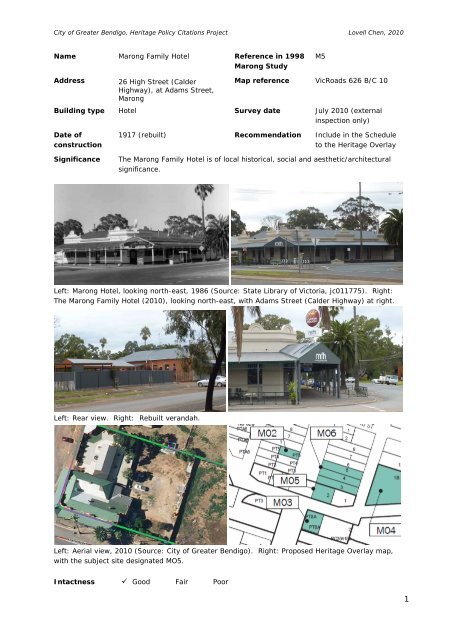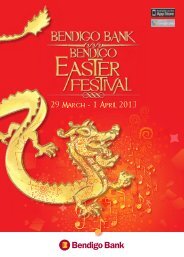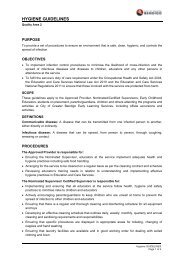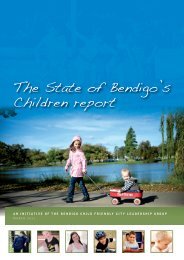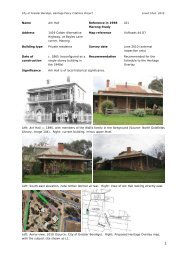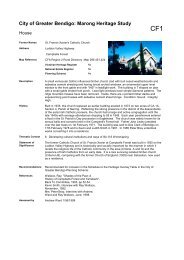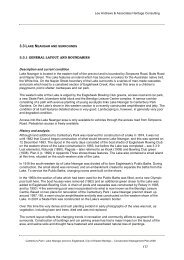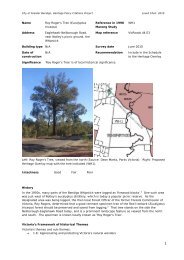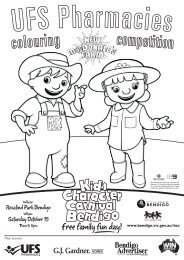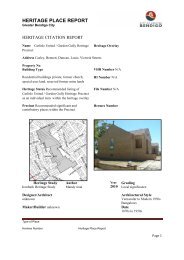Create successful ePaper yourself
Turn your PDF publications into a flip-book with our unique Google optimized e-Paper software.
<strong>City</strong> <strong>of</strong> <strong>Greater</strong> <strong>Bendigo</strong>, Heritage Policy Citations Project Lovell Chen, 2010<br />
Name Marong Family Hotel Reference in 1998<br />
Marong Study<br />
Address 26 High Street (Calder<br />
Highway), at Adams Street,<br />
Marong<br />
M5<br />
Map reference VicRoads 626 B/C 10<br />
Building type Hotel Survey date July 2010 (external<br />
inspection only)<br />
Date <strong>of</strong><br />
construction<br />
1917 (rebuilt) Recommendation Include in the Schedule<br />
to the Heritage Overlay<br />
Significance The Marong Family Hotel is <strong>of</strong> local historical, social and aesthetic/architectural<br />
significance.<br />
Left: Marong Hotel, looking north-east, 1986 (Source: State Library <strong>of</strong> Victoria, jc011775). Right:<br />
The Marong Family Hotel (2010), looking north-east, with Adams Street (Calder Highway) at right.<br />
Left: Rear view. Right: Rebuilt verandah.<br />
Left: Aerial view, 2010 (Source: <strong>City</strong> <strong>of</strong> <strong>Greater</strong> <strong>Bendigo</strong>). Right: Proposed Heritage Overlay map,<br />
with the subject site designated MO5.<br />
Intactness � <strong>Good</strong> Fair Poor<br />
1
<strong>City</strong> <strong>of</strong> <strong>Greater</strong> <strong>Bendigo</strong>, Heritage Policy Citations Project Lovell Chen, 2010<br />
History<br />
The Marong area was squatted from the mid-1840s 1 and used as a gold washing site and<br />
commissioner’s camp from 1852, when the water gave out at <strong>Bendigo</strong>. 2 By 1861 there were 36<br />
dwellings at Marong, <strong>of</strong> which 20 had more than two rooms, eight were <strong>of</strong> canvas and seven <strong>of</strong> slabs<br />
or mud. The majority <strong>of</strong> residents were farmers. 3 In 1865, Marong was described as a ‘small hamlet’<br />
with a population <strong>of</strong> ‘about 50 persons’. 4 By then a hotel, the Marong, was also operating in the<br />
nascent township. 5 By 1867, the premises were conducted by William Lanaby. 6 The hotel burnt down<br />
in 1917, and the present structure was rebuilt on the same site, opposite Marong Shire Hall (built<br />
1908). A small component <strong>of</strong> the old hotel is understood to remain at the rear <strong>of</strong> the present<br />
building. 7 Some early licencees <strong>of</strong> the rebuilt hotel were Alan Hollingworth, Edward Tresize and Arnold<br />
(‘Barney’) Treweek, who had the licence from 1938 to 1949.<br />
Victoria’s Framework <strong>of</strong> Historical Themes<br />
Victoria’s themes and sub-themes:<br />
� 5.6: Entertaining and socialising<br />
� 5.8: Working<br />
Description & Integrity<br />
The Marong Family Hotel is located at the north-east corner <strong>of</strong> Adams Street (Calder Highway) and<br />
High Street (Alternative Calder Highway) in the Marong town centre, opposite Marong Shire Hall. It is<br />
a large, single-storey Federation-era structure <strong>of</strong> brick and stucco, with a horizontal massing. The<br />
hotel addresses both Adams Street to the south and High Street to the west, with a corner splay. The<br />
moulded parapet is prominent and ornamented, comprising finials and semicircular pediments with<br />
rising sun ornamentation in cast cement giving emphasis to the corner and ends <strong>of</strong> each street<br />
elevation. As built, sash windows to the south and west elevations were located between bands <strong>of</strong><br />
render at dado height and surrounding the window tops. The windows to the west elevation and the<br />
westernmost window to the south elevation retain this form, with recessed moulded sills. Other<br />
window openings to the south elevation have been dropped almost to ground level and have plate<br />
glass windows, embossed with the ‘mfh’ logo. Original door openings to the south and west elevations<br />
also have render surrounds. The hipped ro<strong>of</strong> form <strong>of</strong> the main hotel is clad with corrugated sheet<br />
steel, and falls to a central valley, oriented east-west. There are three rendered brick chimneys.<br />
Since the 1990s the black tuckpointed red brick walls have been overpainted (pale/cream) to the<br />
south and west, and the timber post-supported verandah, including corner gable, re-ro<strong>of</strong>ed. The<br />
verandah has a ladder frame frieze. The rear (north) wall <strong>of</strong> the hotel is exposed brick. The opensided<br />
gabled shelter to the rear (beer) garden also appears to be recent. There is no evidence <strong>of</strong><br />
former stables (presumed to have been demolished). The internal public spaces have been altered<br />
and reconfigured.<br />
Although beyond the site boundary, the horse trough (donated bv Anni and George Bill) and palm<br />
trees to the south contribute to the hotel’s streetscape presence.<br />
The Marong Family Hotel appears to be in sound condition.<br />
Comparative Analysis<br />
The Marong Family Hotel, although built in 1917 on the site <strong>of</strong> its fire-damaged predecessor, is<br />
essentially Victorian in detail and form. With its moulded parapet, corner siting, and low, spreading<br />
proportions, it parallels a number <strong>of</strong> other single-storeyed former hotels in the former Rural <strong>City</strong> <strong>of</strong><br />
Marong. These include the former Weighbridge Hotel in Kangaroo Flat, the former Royal Hotel at<br />
Woodvale (also rebuilt in the early twentieth century following a fire), and the former Camp Hotel on<br />
the Neilborough-Eaglehawk Road in the Whipstick. Of these, the Marong Family Hotel is an exception<br />
in being operational. More generally, the low proportions and spreading street frontage typify Central<br />
Victorian hotels and shop buildings in the Loddon Valley and elsewhere, especially on flat sites. They<br />
2
<strong>City</strong> <strong>of</strong> <strong>Greater</strong> <strong>Bendigo</strong>, Heritage Policy Citations Project Lovell Chen, 2010<br />
differ from proportionally similar single-storey hotels in for example, Victoria’s Western District in<br />
having parapet frontages.<br />
Assessment Against Criteria<br />
Amended Heritage Victoria Criteria<br />
Criterion A: Importance to the course, or pattern, <strong>of</strong> the <strong>City</strong> <strong>of</strong> <strong>Greater</strong> <strong>Bendigo</strong>’s cultural history.<br />
The Marong Family Hotel, built in 1917, is <strong>of</strong> historical significance. The first hotel on this prominent<br />
site, at the north-east corner <strong>of</strong> Adams Street and High Street in Marong town centre, was built in the<br />
1860s. The present hotel, built following a fire to its predecessor, has been an operating hotel and<br />
venue for community recreation and entertainment since 1917. It is believed that there are elements<br />
<strong>of</strong> the former hotel at the rear. The new hotel was built shortly after Marong replaced Lockwood North<br />
as the municipal centre <strong>of</strong> the former Shire <strong>of</strong> Marong and can be seen as reflecting the confidence <strong>of</strong><br />
the town at the time.<br />
Criterion B: Possession <strong>of</strong> uncommon, rare or endangered aspects <strong>of</strong> the <strong>City</strong> <strong>of</strong> <strong>Greater</strong> <strong>Bendigo</strong>’s<br />
cultural history.<br />
N/A<br />
Criterion C: Potential to yield information that will contribute to an understanding <strong>of</strong> the <strong>City</strong> <strong>of</strong><br />
<strong>Greater</strong> <strong>Bendigo</strong>’s cultural history.<br />
N/A<br />
Criterion D: Importance in demonstrating the principal characteristics <strong>of</strong> a class <strong>of</strong> cultural places or<br />
objects.<br />
N/A<br />
Criterion E: Importance in exhibiting particular aesthetic characteristics in the context <strong>of</strong> the<br />
municipality.<br />
The Marong Family Hotel, built in 1917, is <strong>of</strong> aesthetic/architectural significance. Although built in the<br />
Federation period, and substantially intact to that date, it is essentially Victorian in form and<br />
proportions. In its moulded parapet, and low, spreading proportions, it parallels a number <strong>of</strong> other<br />
single-storeyed former hotels in the former Rural <strong>City</strong> <strong>of</strong> Marong, including the former Weighbridge<br />
Hotel in Kangaroo Flat, the former Royal Hotel at Woodvale (also rebuilt in the early twentieth century<br />
following a fire), and the former Camp Hotel on the Neilborough-Eaglehawk Road in the Whipstick.<br />
The prominent and ornamented parapet, including finials and semicircular pediments with rising sun<br />
ornamentation in cast cement, which give emphasis to the corner and ends <strong>of</strong> each street elevation, is<br />
a distinguishing element <strong>of</strong> the Marong Family Hotel. Recent works, including dropped windows and<br />
overpainting, have not significantly diminished its capacity to demonstrate the original design intent.<br />
The hotel is also a prominent element <strong>of</strong> the streetscape, being located at the town’s principal<br />
intersection, and opposite the former Shire <strong>of</strong> Marong hall.<br />
Criterion F: Importance in demonstrating a high degree <strong>of</strong> creative or technical achievement at a<br />
particular period.<br />
N/A<br />
Criterion G: Strong or special association with a particular community or cultural group for social,<br />
cultural or spiritual reasons. This includes the significance <strong>of</strong> the place to Indigenous peoples as part<br />
<strong>of</strong> their continuing and developing cultural traditions.<br />
The Marong Family Hotel is <strong>of</strong> local social significance. It is a hotel which has operated continuously<br />
since 1917, on the site <strong>of</strong> an even earlier hotel, and as such has been a valued focus <strong>of</strong> local<br />
3
<strong>City</strong> <strong>of</strong> <strong>Greater</strong> <strong>Bendigo</strong>, Heritage Policy Citations Project Lovell Chen, 2010<br />
community recreation and entertainment for many decades. Its prominent corner location, in the<br />
centre <strong>of</strong> town, enhances this aspect <strong>of</strong> significance.<br />
Criterion H: Special association with life or works <strong>of</strong> a person, or group <strong>of</strong> persons, <strong>of</strong> importance in<br />
the <strong>City</strong> <strong>of</strong> <strong>Greater</strong> <strong>Bendigo</strong>’s history.<br />
N/A<br />
Statement <strong>of</strong> Significance<br />
What is significant?<br />
The Marong Family Hotel was built in 1917 at the north-east corner <strong>of</strong> Adams and High streets in the<br />
Marong town centre. It replaced an earlier hotel on the site which was burnt down in 1917. The<br />
building is a large, single-storey Federation-era structure <strong>of</strong> brick and stucco, with a horizontal<br />
massing and low, spreading proportions. The hotel addresses both Adams Street to the south and<br />
High Street to the west, with a corner splay and prominent and ornamented moulded parapet. The<br />
sash windows to the west elevation and the westernmost window to the south elevation retain their<br />
original form, while other window openings to the south elevation have been dropped almost to<br />
ground level and have had plate glass added. Original door openings to the south and west elevations<br />
also have render surrounds. The hipped ro<strong>of</strong> form <strong>of</strong> the main hotel is clad with corrugated sheet<br />
steel, and falls to a central valley; there are three rendered brick chimneys. The timber postsupported<br />
verandah has a ladder frame frieze. The brick walls have been overpainted to the south<br />
and west, while the rear (north) wall <strong>of</strong> the hotel is exposed brick.<br />
How is it significant?<br />
The Marong Family Hotel is <strong>of</strong> local historical, social and aesthetic/architectural significance.<br />
Why is it significant?<br />
The Marong Family Hotel is historically significant (Criterion A) for occupying the site <strong>of</strong> the earlier<br />
1860s hotel on this prominent location, and for replacing this building, following a fire, in 1917. It has<br />
since that time operated as a hotel and venue for community recreation and entertainment. The<br />
current hotel was also built shortly after Marong replaced Lockwood North as the municipal centre <strong>of</strong><br />
the former Shire <strong>of</strong> Marong and can be seen as reflecting the confidence <strong>of</strong> the town at the time. The<br />
Marong Family Hotel is <strong>of</strong> local social significance (Criterion G), as a hotel which has operated<br />
continuously since 1917 and as such has been a valued focus <strong>of</strong> local community recreation and<br />
entertainment for many decades; this role is enhanced by its prominent corner location in the centre<br />
<strong>of</strong> town.<br />
The Marong Family Hotel is also <strong>of</strong> aesthetic/architectural significance (Criterion E). Although built in<br />
the Federation period, and substantially intact to that date, it is essentially Victorian in form and<br />
proportions. In its moulded parapet, and low, spreading proportions, it parallels a number <strong>of</strong> other<br />
single-storeyed former hotels in the former Rural <strong>City</strong> <strong>of</strong> Marong. The prominent and ornamented<br />
parapet, including finials and semicircular pediments with rising sun ornamentation in cast cement,<br />
which give emphasis to the corner and ends <strong>of</strong> each street elevation, is a distinguishing element <strong>of</strong> the<br />
Marong Family Hotel. The hotel is also a prominent element <strong>of</strong> the streetscape, being located at the<br />
town’s principal intersection, and opposite the former Shire <strong>of</strong> Marong hall.<br />
Recommendations<br />
The property is recommended for inclusion in the Schedule to the <strong>Greater</strong> <strong>Bendigo</strong> Heritage Overlay.<br />
The recommended extent <strong>of</strong> Overlay coverage is indicated in the above map. The focus <strong>of</strong> significance<br />
is on the main historic building component, and its corner presentation. The elements on the north<br />
side <strong>of</strong> the hotel, including the open-sided gabled shelter, are not significant. In preference, the<br />
external paint treatment should be removed, and the original facebrick presentation <strong>of</strong> the building<br />
reinstated.<br />
4
<strong>City</strong> <strong>of</strong> <strong>Greater</strong> <strong>Bendigo</strong>, Heritage Policy Citations Project Lovell Chen, 2010<br />
External Paint Colours No<br />
Internal Alterations Controls No<br />
Tree Controls No<br />
Outbuildings and fences exemptions No<br />
Victorian Heritage Register No<br />
Prohibited uses may be permitted No<br />
Incorporated plan No<br />
Aboriginal heritage place No<br />
Identified By<br />
Andrew Ward, 1998.<br />
References<br />
Mike Butcher and Gill Flanders, <strong>Bendigo</strong> Historic Buildings, National Trust <strong>of</strong> Australia (Vic), 1987.<br />
Ruth Hopkins, Moving Forward Looking Back, Shire <strong>of</strong> Marong, 1985.<br />
David Horsfall, Kangaroo Flat, A History, Gold, Goats and Peppercorns, Back To Committee, 1993.<br />
Andrew Ward et al, <strong>City</strong> <strong>of</strong> <strong>Greater</strong> <strong>Bendigo</strong> Heritage Study (Marong) Study Area, Stage 2, 1998.<br />
Specific:<br />
1<br />
Ken Arnold, <strong>Bendigo</strong> its Environs, The Way it Was, Volume 1, Crown Castleton Publishers,<br />
2003, p. 123.<br />
2<br />
Andrew Ward, <strong>City</strong> <strong>of</strong> <strong>Greater</strong> <strong>Bendigo</strong> (Marong District) Heritage Study (Stage One Report),<br />
unpaginated.<br />
3<br />
Ruth Hopkins, Moving Forward, Looking Back, The History <strong>of</strong> the Marong Shire, Shire <strong>of</strong><br />
Marong, 1985, p. 13.<br />
4<br />
F F Bailliere, in the Victorian Gazetteer and Road Guide, 1865, p. 238.<br />
5<br />
F F Bailliere, in the Victorian Gazetteer and Road Guide, 1865, p. 238.<br />
6<br />
‘Marong hotel’ citation, Andrew Ward et al, <strong>City</strong> <strong>of</strong> <strong>Greater</strong> <strong>Bendigo</strong> Heritage Study (Marong)<br />
Study Area, Stage 2, 1998. Source uncited.<br />
7 ‘<br />
Marong hotel’ citation, Andrew Ward et al, <strong>City</strong> <strong>of</strong> <strong>Greater</strong> <strong>Bendigo</strong> Heritage Study (Marong)<br />
Study Area, Stage 2, 1998. Source uncited, possibly pers comm., Jean Thomas interview with<br />
Ray Wallace (historian), 11 March1999.<br />
5


